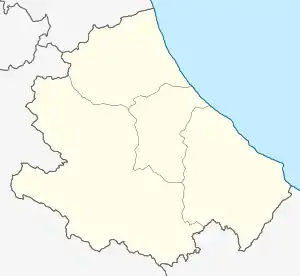Altino, Abruzzo
Altino (Abruzzese: Davëdìnë) is a comune and town in the province of Chieti in the Abruzzo region of southern Italy. It is located on a rock spur commanding the valley of the Aventino river. The valley is richly cultivated with orchards, fruit, grapes and olives.
Altino | |
|---|---|
| Comune di Altino | |
.JPG.webp) Altino-Stemma.png | |
Location of Altino | |
 Altino Location of Altino in Italy  Altino Altino (Abruzzo) | |
| Coordinates: 42°6′N 14°20′E | |
| Country | Italy |
| Region | Abruzzo |
| Province | Chieti (CH) |
| Frazioni | Briccioli, Sant'Angelo, Fonte, Luzio, Mandrella, Rio Secco, Scosse, Colli d Altino , Selva di Altino |
| Government | |
| • Mayor | Vincenzo Muratelli |
| Area | |
| • Total | 15.33 km2 (5.92 sq mi) |
| Elevation | 345 m (1,132 ft) |
| Population (31 March 2017)[2] | |
| • Total | 3,113 |
| • Density | 200/km2 (530/sq mi) |
| Demonym | Altinesi |
| Time zone | UTC+1 (CET) |
| • Summer (DST) | UTC+2 (CEST) |
| Postal code | 66040 |
| Dialing code | 0872 |
| ISTAT code | 069001 |
| Patron saint | San Gilberto |
| Saint day | 4 September |
| Website | Official website |
Geography
Altino is located on a rocky spur overlooking the valley of the Aventino river, at the foot of Monte Calvario. At 345 m above sea level Altino dominates a wide expanse of valley, rich of farms and orchards in the lower part, of vineyards and olive trees in the hilly area
History
Legend has it that Altino was founded in 452 by Venetian refugees fleeing from Attila, who had burned the Roman military port in Altinum (today Quarto d'Altino).
In fact, the origin of the village dates back to medieval times. A first attestation in historical documents dates back to the 12th century. In the Norman age Altino was a fief of Bohemond I of Antioch.
In the first half of the 15th century Altino belonged to the Lordship of Raimondo Anichino. The Anichino family held the castle until 1534; later, perhaps due to the extinction of the family, Altino was donated to Diego De Mocciacao. In 1561 the whole village was sold to Giovanni Vincenzo Crispano. In 1613 Altino passed into property to the baron Furia di Atessa. In 1691 he went, for 5,000 ducats, to the Paolucci family of Naples. The town suffered looting and raids by brigands in the late days of Kingdom of Two Sicilies (mid/late-19th century).
Main sights
Buildings
.JPG.webp)
- Church of the Madonna delle Grazie
- Parish Church of Santa Maria del Popolo, known from the 14th century
- Church of San Rocco
- Palazzo Sirolli
- Monumental Fountain (1558)
Natural Areas
- The sulphurous spring in the Briccioli district.
- The rock massif from the church of Santa Maria del Popolo.
- Lake Serranella.
Culture
Feasts include:
- Festival del Peperone Dolce di Altino e dell'Oasi di Serranella (ultimo weekend di agosto)
- Festa della Madonna delle Grazie (15 e 16 maggio)
- Festa dei Santi Medici Cosma e Damiano (26 e 27 settembre): per la festa dei Santi Medici si ripete nei paesi di Altino, Lentella e Roccascalegna l'uso dei donativi cereali ed alimentari, offerti per grazia ricevuta.
Sources
- Sirolli, Francesco S. (1997). Altino: storia, cronaca, leggenda. Lanciano: Rocco Carabba.
- "Superficie di Comuni Province e Regioni italiane al 9 ottobre 2011". Italian National Institute of Statistics. Retrieved 16 March 2019.
- "Popolazione Residente al 1° Gennaio 2018". Italian National Institute of Statistics. Retrieved 16 March 2019.